The Lifespan of Smooth Solutions to Semilinear Wave Equations in Schwarzschild Space-Time
LOU Qiong and LUO Shaoying
1 School of Science,Zhejiang University of Science and Technology,Hangzhou 310023,China.
2 Faculty of Science,Ningbo University of Technology,Ningbo 315211,China.
Abstract. This paper considers the Cauchy problem of the semilinear wave equations with small initial data in the Schwarzschild space-time,□gu=|ut|p,where g denotes the Schwarzschild metric.When 1<p<2 and the initial data are supported far away from the black hole,we can prove that the lifespan of the spherically symmetric solution obtains the same order as the semilinear wave equation evolving in the Minkowski space-time by introducing an auxiliary function.
Key Words: Semilinear wave equations;Schwarzschild spacetime;blow-up;lifespan.
1 Introduction
In this paper,we consider the blow-up phenomenon of the solution to the following nonlinear wave equation
wheregdenotes the metric of the Schwarzschild space-time andp>1.
In the Minkowski spacetime,the critical exponent isp(n)=,in whichnis the spatial dimension.It is well-known that when 1<p ≤p(n),the solution blows up even for small initial data;whenp>p(n),global solution for small initial data exists.The blowup results were first established by F.John[1]whenn=3.Whenn=2,such results were given by J.Schaeffer[2]as well as R.Agemi[3].Whenn=1,K.Masuda[4]proved the same result.The radially symmetric solutions also blow up whenn≥4 withp=p(n)ifnis odd,and 1<p<p(n)whennis even.The lifespan of solution was also discussed in some papers.Li and Chen[5]studied the lower bound of the lifespan.The lifespan is proved to be sharp as in Lax [6],F.John [7],Kong [8] and Y.Zhou [9],while the general result was obtained in Y.Zhou[10].For the blow-up of solutions with variable coefficients on exterior domain,see Y.Zhou and W.Han in[11].
Recently,the study of hyperbolic partial differential equations in curved space-time has draw much attention of the mathematicians,due to the great development of the general relativity.We want to know whether the results of hyperbolic PDEs in Minkowski space-time are still hold in curved space-time.One can see[12-16]for the perfect fluids in FLRW spacetimes,and see [17-19] for nonlinear wave equations in de Sitter spacetime.In this paper,we are interested in the lifespan of smooth solutions to the semilinear wave equations evolving in Schwarzschild space-time.When the nonlinear term is|u|pwith 3/2≤p ≤2,the lifespan has been studied by Lin,Lai and Ming [20].When the nonlinear term is|ut|pwith 1<p<2,Lai and Zhou[21]studied the lifespan of the spherically symmetric solution.The general results on the Glassey conjecture for all spatial dimensions with radially symmetric data is studied by Hidano Wang and Yokoyama,see[22].Inspired by Y.Zhou and W.Han in[11],We consider the semilinear wave equations evolving in the Schwarzschild space-time when 1<p<p(n).We can prove that the lifespan isT(ε)≤,which has the same order as the Minkowski case.
1.1 Main theorem
Consider the nonlinear wave equations in the Schwarzschild spacetimeM
The Schwarzschild metricgis
hereM >0 denotes the mass of the universe anddω2is the standard metric on the unit sphereS2,r>2M.Denoting
the D’Alembert operator associated with metricgbecomes
where△S2is the standard Laplace-Beltrami operator onS2.
Define the Regge-Wheeler coordinate
and we can rewrite(1.2)as
whereF=F(s)=1-andr(s) denotes the inverse function ofs(r) given in(1.6).We assume that the solution is spherical symmetry,that isu=u(t,s).Eq.(1.7)reduces to
Making the substitution
we obtain the nonlinear Cauchy problem in the following:
wherep>1,ε>0 is small,
f,gare smooth non-negative functions with compact support:
Ais a big constant.The above assumptions imply that the small initial data supports far away from the black hole.Obviously,W(s),f(s)∈C(R)satisfy:
Then our main result can be described as
Theorem 1.1.Under the above assumptions,let T(ε)be the lifespan of(1.10),when1<p<2(=,n=3),there exists a positive constantwhich is independant of ε such that
Remark 1.1.The local well-posedness of this problem has been intensively studied in Sobolev space,see[22]for detailed conclusions.
2 Proof of Theorem 1.1
The following lemma is important for the proof of the main theorem,which comes from Lemma 5.4 in[23].
Lemma 2.1.Given any D>0,the equation
admits a positive solution ψ(s)∈C2(R)such that ψ(s)~eDs as|s|approaches∞.
Proof of Theorem1.1.Define
Differentiating(1.10)bytwe can obtain
Multiplying the above equation by Ψ(t,s)and integrating on[0,t]×R,
Denote the left side of(2.10)byIand the right side byII,noting(2.5),(2.6),then
Since
then
On the other side,
CombiningI,II,Eq.(2.2)and noting thatvis the solution of(1.10),
Integrating on[0,t]gives
Then,
The last inequality comes from the assumptions onf,gand the property ofψ,whereNis a positive constant.We can also obtain thatF(t)≥0 for anyt≥0.
As|s-s0|≤t+R,later we will prove that the lifespan is less thans0-R-1 for bigA,that iss ≥s0-t-R ≥1.According to(1.14),f ~s1-p,by H¨older inequality and(2.7)we have
that is,
hereCis a positive constant and can change from line to line.Then,(2.18)becomes
Letω(t)be the function satisfying
thenF(t)≥ω(t)and the lifespan ofFis less than the one ofω.ω(t)satisfies the ODE
with initial data
Then we get
Solving above ODE,we have
whereC1,C2are constants andR≪s0.Sinces0=,then
with bigA.Thus,we have
The result shows the lifespan here in the Schwarzschild spacetime has the same order with the Minkowski case.
Acknowledgment
This research is supported in part by Zhejiang Provincial Natural Science Foundation of China(Grant No.LY22A010003).
 Journal of Partial Differential Equations2023年4期
Journal of Partial Differential Equations2023年4期
- Journal of Partial Differential Equations的其它文章
- Lipschitz Continuity and Explicit Form of Solution in a Class of Free Boundary Problem with Neumann Boundary Condition
- Asymptotic Stability for a Quasilinear Viscoelastic Equation with Nonlinear Damping and Memory
- Free Boundaries Problem for a Class of Parabolic Type Chemotaxis Model
- Blowup of the Solutions for a Reaction-Advection-Diffusion Equation with Free Boundaries
- Extremal Functions for an Improved Trudinger-Moser Inequality Involving Lp-Norm in Rn
- Modified Differential Transform Method for Solving Black-Scholes Pricing Model of European Option Valuation Paying Continuous Dividends
